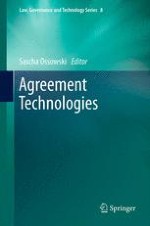2013 | OriginalPaper | Buchkapitel
13. AI and Law
verfasst von : Giovanni Sartor, Antonino Rotolo
Erschienen in: Agreement Technologies
Verlag: Springer Netherlands
Aktivieren Sie unsere intelligente Suche, um passende Fachinhalte oder Patente zu finden.
Wählen Sie Textabschnitte aus um mit Künstlicher Intelligenz passenden Patente zu finden. powered by
Markieren Sie Textabschnitte, um KI-gestützt weitere passende Inhalte zu finden. powered by
